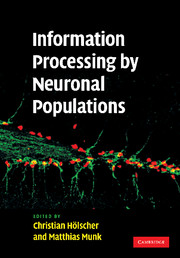Book contents
- Frontmatter
- Contents
- List of contributors
- Part I Introduction
- Part II Organization of neuronal activity in neuronal populations
- 2 Cellular mechanisms underlying network synchrony in the medial temporal lobe
- 3 Cell assemblies and serial computation in neural circuits
- 4 Neural population recording in behaving animals: constituents of a neural code for behavioral decisions
- 5 Measuring distributed properties of neural representations beyond the decoding of local variables: implications for cognition
- 6 Single-neuron and ensemble contributions to decoding simultaneously recorded spike trains
- Part III Neuronal population information coding and plasticity in specific brain areas
- Part IV Functional integration of different brain areas in information processing and plasticity
- Part V Disturbances of population activity as the basis of schizophrenia
- Part VI Summary, conclusion, and future targets
- Index
- References
2 - Cellular mechanisms underlying network synchrony in the medial temporal lobe
Published online by Cambridge University Press: 14 August 2009
- Frontmatter
- Contents
- List of contributors
- Part I Introduction
- Part II Organization of neuronal activity in neuronal populations
- 2 Cellular mechanisms underlying network synchrony in the medial temporal lobe
- 3 Cell assemblies and serial computation in neural circuits
- 4 Neural population recording in behaving animals: constituents of a neural code for behavioral decisions
- 5 Measuring distributed properties of neural representations beyond the decoding of local variables: implications for cognition
- 6 Single-neuron and ensemble contributions to decoding simultaneously recorded spike trains
- Part III Neuronal population information coding and plasticity in specific brain areas
- Part IV Functional integration of different brain areas in information processing and plasticity
- Part V Disturbances of population activity as the basis of schizophrenia
- Part VI Summary, conclusion, and future targets
- Index
- References
Summary
Introduction
The hippocampus lies at the apex of the hierarchical organization of cortical connectivity, receiving convergent multimodal inputs that are funneled through the adjacent entorhinal cortex (Fig. 2.1). The output of the hippocampus is relayed back through the entorhinal cortex, and thus these structures are ideally placed to both store novel associations and detect predictive errors (Lavenex and Amaral,2000; Witter et al., 2000). Indeed, while memories are likely to be stored across distributed brain regions, the learning and consolidation of explicit memories appear to depend upon the hippocampus and surrounding parahippocampal regions (Morris et al., 2003; Squire et al., 2004). However, while the anatomical substrate of such learning is becoming increasingly well defined, it remains unclear how cells act collectively within these neuronal networks to extract and store salient input correlations.
Over 50 years ago, Donald Hebb postulated a simple cellular learning rule, whereby the strength of the synaptic connection between two neurons would be increased if activity in the presynaptic neuron persistently contributed to discharging the postsynaptic neuron (Hebb, 1949). It has since then been shown that such repeated pairings of synaptic events with postsynaptic action potentials (spikes), within a window of tens of milliseconds, can produce long-term changes in synaptic efficacy in many different neuronal systems, both in vitro and in vivo (Paulsen and Sejnowski, 2000; Bi and Poo, 2001).
- Type
- Chapter
- Information
- Information Processing by Neuronal Populations , pp. 21 - 48Publisher: Cambridge University PressPrint publication year: 2008

